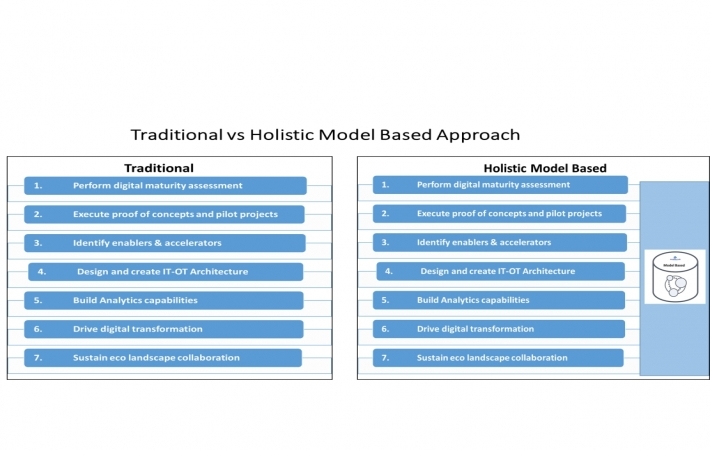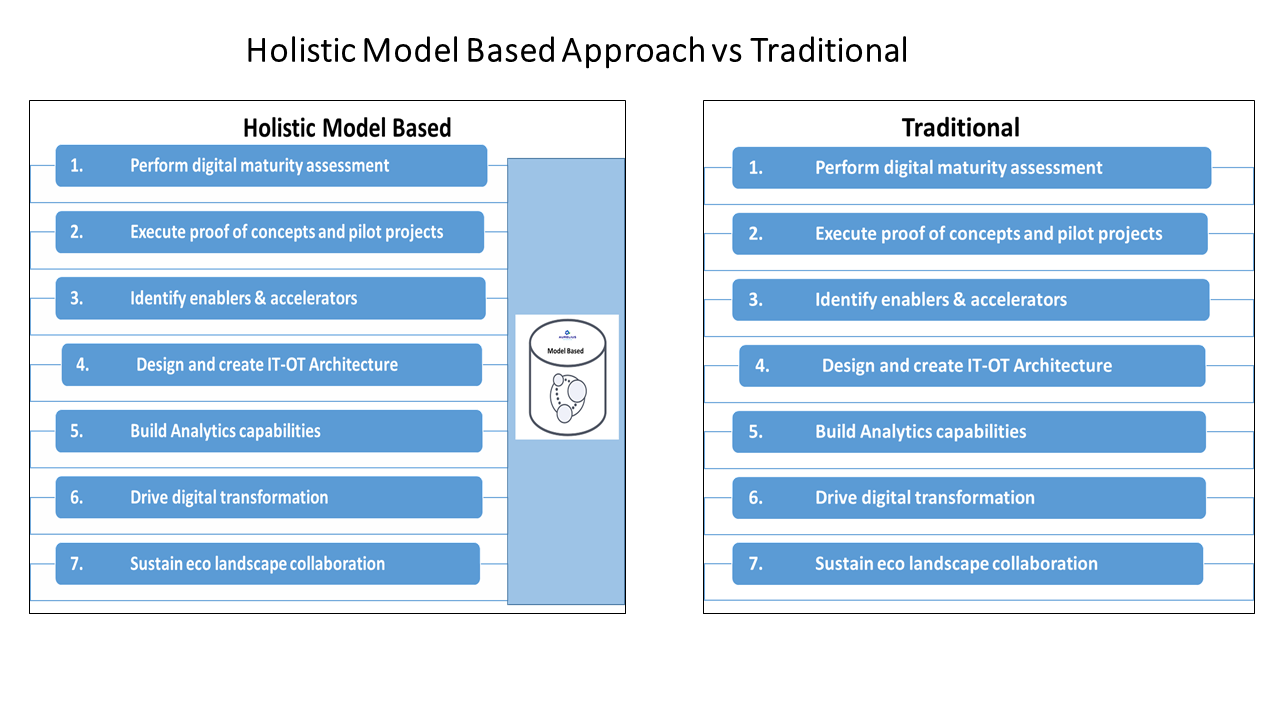
Published on 07/25/2017 | Strategy
Where earlier industrial revolutions were marked by single technology innovation, the 4th industrial revolution includes several major technology innovations.
Industry 4.0 definitions refer to the combination of multiple major technology innovations. However, it is necessary to realize that enterprises need to undergo a major transformation, which is usually performed using a pragmatic agile approach. Current approaches have revealed to be insufficient to drive digital transformation projects for Industry 4.0, simply because they lack insight for the broad variety of stakeholders. As a consequence, these projects are often over budget, over time or even terminated. In other cases, these projects are not even able to kick off. Three of many examples are:
Traditional approaches focus on a single system at a time; however, in Industry 4.0 everything is much more connected and integrated and therefore the dependencies are a multifold higher than in current environments. These interdependencies require projects to use a holistic approach and manage these dependencies. To be able to achieve this, a digitized model based approach is proposed that can be used to drive the full life cycle of such transformation.
These models will be key for Industry 4.0 transformation, the solution approach in this paper is a holistic model based transformation approach.
In this paper, the approach is described on an impact level, while the details of the modeling solution itself will be described in a separate paper.
Besides several major technology innovations, Industry 4.0 is also characterized by new ways of collaboration, product development, the need for integrated horizontal and vertical value chains and new business models. All these need to be fully transparent and give the right (exception based) insights to the user, anytime, anywhere.
The fundamentals of the proposed solution are based on dynamic system thinking and modeling. In the holistic model based approach 6 constituents are defined for Industry 4.0 transformation that can be described as dimensions.
Six integrated dimensions are defined:
Following such a solution approach makes it possible to structure, organize and execute in an agile matter, with full flexibility executing the strategy and roadmap.
However, the typical Industry 4.0 transformation challenge remains: the transformation is overwhelming and difficult to control. This is where the holistic model based solution and the need for digitized dynamic models kicks in. For this the following possible model types are defined: dimensions, subsystem, building blocks and artifacts.
Dimensions are incrementally created and extended following a bottom-up approach. A dimension is first instantiated with small building blocks that at least as a whole or partly can be reused in subsystems, which at the end will contribute in defining the dimension. Artifacts can be created by combining dimensions, subsystems and/or building blocks. Artifacts can fulfill the dynamics of the Industry 4.0 using transformation cases. A project usually produces an artifact containing multiple building blocks that belong to different dimensions.
A key artifact is the IT-OT architecture that merges the Information Technology and the Operational Technology worlds and contains the integrated constituents of the above. A holistic model based approach makes it possible for enterprises to design, build and implement their IT-OT architecture with optimal flexibility.
As Industry 4.0 includes mission critical, high performance, quality and rapid market demand behavior, the models should be formalized, sustainable and at the same time be accessible and interactive in the different system dimensions through the subsystems and building blocks.
In general, a holistic model based solution for Industry 4.0 should exist of at least the following components:
To directly receive value out of holistic models, a seven-step approach is described that creates a path towards Industry 4.0 transformation.
The main difference to a typical traditional approach is that the steps are supported by dynamic digitized models.
 Within each of these steps sprints can be defined, using the models to:
Within each of these steps sprints can be defined, using the models to:
An example is used to explain the advantages of using the holistic model based approach vs. the traditional approach. In this example two use cases ‘real-time process track and control’ and ‘real- time visualization and action taking’, projects are running.
On the right side, a typical traditional approach shows that there is interoperability and dependencies between several initiatives, but there is no mechanism to capture and align the impact between the several initiatives. This increases complexity, uncertainty, level of assumptions, misinterpretation and miscommunication.
The left side shows the holistic model based approach, where several initiatives are supported and guided by respective Industry 4.0 models to incorporate and mange interoperability and dependencies. The model based repository handles the complexity in the background while updating the models with all changes. Each designated user can have customized access and have joined interpretation and a collaborative way of working. The user can perform analytics on the models to receive insight on the requirements and respective goals.
For each of the projects the relation with the transformation dimensions can be understood, making it possible to manage and have insight on interoperability and dependencies.
 Typically, an enterprise will have multiple initiatives at the same time, increasing the challenges for Industry 4.0 transformation. This is where the holistic model based approach will make sure to provide full clarity and control, regardless of the number of initiatives, their interoperability and the dependencies during their lifecycle.
Typically, an enterprise will have multiple initiatives at the same time, increasing the challenges for Industry 4.0 transformation. This is where the holistic model based approach will make sure to provide full clarity and control, regardless of the number of initiatives, their interoperability and the dependencies during their lifecycle.
To be able to drive transformation with a magnitude as Industry 4.0, a solution approach is needed that is capable to handle, simplify and visualize the complexity and dynamics of Industry 4.0 in an agile matter. The holistic model based approach is suitable to facilitate the life cycle of Industry 4.0 transformation making sure enterprises capture the full potential of it.
Note that the model based repository details will be described in a separate paper.
Marlon Hiralal ( https://www.linkedin.com/in/marlon-hiralal-a23477/ ) is a senior hands-on expert within the Digital Transformation, Industry 4.0, Industrial Internet of Things and Smart Factory domain. Based out from Europe he supports enterprises with their strategy, architecture and transformation into the Industry 4.0 era.